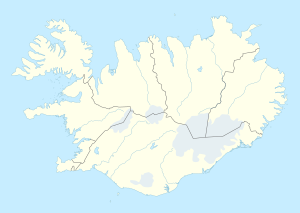Kárahnjúkar power plant
| Kárahnjúkar power plant | ||
|---|---|---|
| The dam | ||
| location | ||
|
|
||
| Coordinates | 64 ° 57 ′ 0 ″ N , 15 ° 47 ′ 0 ″ W | |
| country |
|
|
| Waters | Jökulsá á Brú , Jökulsá í Fljótsdal | |
| power plant | ||
| operator | Landsvirkjun | |
| Start of operation | November 30, 2007 | |
| technology | ||
| Bottleneck performance | 690 megawatts | |
| Average height of fall |
almost 600 m | |
| Standard work capacity | 4800 million kWh / year | |
| Others | ||
The Kárahnjúkar power plant ( isl. Kárahnjúkavirkjun or Fljótsdalsstöð ) is a hydroelectric power plant in eastern Iceland . With an output of 690 MW , a reservoir with an area of 57 km² and a main dam with a length of 700 m and a height of 198 m, it is one of the largest hydropower plants in Europe. It can deliver 4800 GWh per year.
construction
The water of two rivers, Jökulsá á Brú (= Jökulsá á Dal) and Jökulsá í Fljótsdal is stored in three reservoirs ( Hálslón , Ufsalón and Keldulón ). From there it is directed to the power plant via two 40 km and 13 km long tunnels with a diameter of around 7.5 m and 6 m. The tunnels have a slight tendency to transport water into another valley in order to achieve a greater drop height there compared to the pure dam height. After the tunnels have merged, the water flow is separated into two tunnels of the same size, each approx. 4 m in diameter, about 800 m in front of the power plant. After a stone trap, which is supposed to protect the power plant turbine from being carried away, the tunnel goes into an almost vertical pressure gallery to the power plant. A difference in altitude of 420 m is only overcome on the last few meters. Shortly before the vertical change in direction, the water tunnels make a curve with an exit portal. In the event of an emergency shutdown of the power plant, the kilometer-long inlet tunnels can be drained through this gate. Due to the length of the tunnels, they were built from several sides at the same time. For the first time, tunnel boring machines were used on Iceland , which in this case bored directly into the rock without installing a lining. On September 28, 2006, the water in the Hálslón was dammed for the first time.
The water is led into the Jökulsá í Fljótsdal into the lake Lögurinn and flows over the Lagarfljót into the Atlantic Ocean .
purpose
The power plant supplies energy for the aluminum plant Fjardaál company Alcoa in Reyðarfjörður (about 100 km north-east). This has created several hundred jobs in East Iceland. Under certain circumstances, the aluminum plant should be enlarged in the next few years. Most of the power plant was built by foreign companies, including the Hochtief group from Essen and Impregilo SpA from Italy. The operator is the Icelandic energy supply company Landsvirkjun .
criticism
Due to the construction, large natural areas were lost, where reindeer spent the winter in Iceland. The reservoir is located in the heart of the second largest untouched natural area, which is around 1000 km².
The political decisions that led to the construction are also controversial. The last time there was excitement in the Icelandic media and parliament was in the fall of 2006, when it became known in an interview by Alcoa board member Alain J. P. Belda with a Brazilian newspaper that the Icelandic state energy supplier and future dam operator Landsvirkjun Alcoa allegedly only offered a price of around Charged 15 dollars per megawatt hour , much less than Icelandic citizens or companies usually have to pay. Landsvirkjun said the price was too low, Alcoa removed the article from its website and apologized to Landsvirkjun for the confusion. The actual price has not yet been published. The value of this power plant is 65% of the value of all power plants of the utility company. But it only generates 32% of sales. The power plant was officially put into operation on November 30, 2007. By then, more than a billion euros had gone into the construction. There were also additional costs for the infrastructure.
Individual evidence
- ↑ Kárahnjúkar dam not profitable. Iceland Review, November 21, 2011, accessed June 8, 2020 .
Web links
- Side of Landsvirkjun ( English )
- Jessica Sturmberg: Between nature conservation and industrialization - Iceland elects a new parliament , Deutschlandfunk - “ Background ” from May 12, 2007
- Report in the Taz
- a report on guardian.co.uk (English)
- Network Saving Iceland with criticism of the project (English)
- The Kárahnjúkar power plant - Iceland-Travel Guide island.de (with picture of the construction of the dam)
- "MegaStructures - Icelandic Super Dam (National Geographic Documentary)" English TV documentary of the construction



